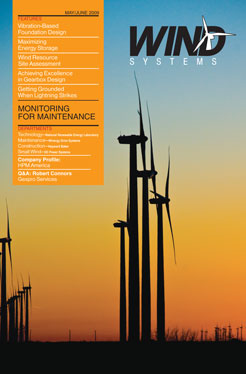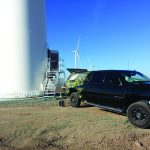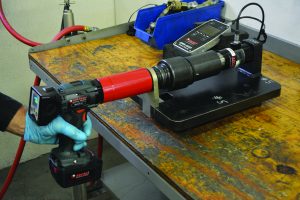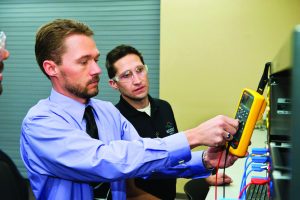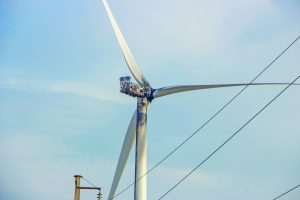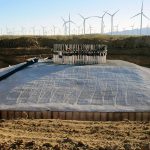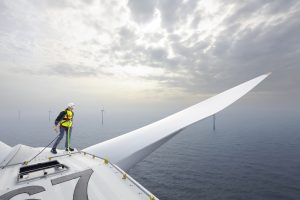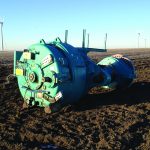“You make ‘em, we’ll break ‘em” could be the motto of the National Renewable Energy Laboratory’s (NREL’s) National Wind Technology Center (NWTC). Located just south of Boulder, Colorado, it is the U.S. Department of Energy’s premier wind energy research facility. At the NWTC researchers work with industry partners, testing full-scale wind turbines and their components to their limits to identify and resolve reliability issues and validate the performance of new designs before manufacturers risk millions of dollars on commercial production. The goal of this research is to assist U.S. industry in developing cost-effective, high-performance wind turbine technology that will compete in global energy markets. To that end NREL researchers work closely with industry partners to research, design, build, test, and refine advanced wind turbine designs.
Located at the foot of the Colorado Rockies, the location is ideal because it experiences two distinct wind patterns. First, strong westerly winds sweep across the continental divide during the fall and winter. These winds accelerate as they blast over the ridges and down through the canyons along the Colorado Front Range, occasionally reaching speeds exceeding 120 miles per hour and providing the severe testing environment needed for validating wind turbine reliability and performance. The second wind pattern occurs in late winter and spring, when smooth stable easterly and northeasterly winds blow in from the Great Plains. These winds are equally important because they are ideal for validating wind turbine performance under typical Midwest conditions.
As the only facility in the United States accredited through the American Association of Laboratory Accreditation (A2LA) to perform several critical tests, the NWTC provides the high quality testing required by wind turbine certification agencies, financial institutions, and other organizations throughout the world. Tests accredited by A2LA to International Electrotechnical Commission (IEC) Standards include wind turbine noise, power performance, power quality, and several structural safety, function, and duration tests.
The NWTC has multiple test sites that manufacturers can use to evaluate prototype machines under extreme conditions. In 2009 the center will begin working with Siemens to install and test its 2.3-MW late-stage prototype. The new machine’s rotor spans 101 m and features a novel blade design that captures more of the wind’s energy, but should not force any more load onto the turbine’s moving parts and control systems. The turbine will be heavily instrumented to produce a constant stream of data.
Dynamometer Test Facilities: The NWTC’s 225-kW and 2.5-MW dynamometer test facilities provide industry with a way to conduct a range of system tests that can’t be duplicated in the field. These tests include gearbox fatigue, wind turbine control simulations, transient operation, and generator and power system component efficiency and performance tests. A few months of endurance testing on the 2.5-MW dynamometer can provide engineers with an equivalent of 30 years of use and a lifetime of braking cycles to help them determine which components are susceptible to wear.
Blade Test Facilities: NREL works with industry partners to verify new blade designs and materials. As wind turbines grow in size and their blades become longer and more flexible, it becomes more difficult to test the blades for endurance. To test the new, larger blades, NREL installed a larger blade test stand capable of testing blades up to 50 m in length. The tests include fatigue and ultimate static strength, as well as several nondestructive techniques such as photoelastic stress visualization, thermographic stress visualization, and acoustic emissions. NREL is working with consortiums in Massachusetts and Texas to develop two new blade test facilities capable of testing blades up to 80 m.
As today’s utility-scale wind turbines become taller and more flexible, researchers at the NWTC are investigating ways to mitigate system fatigue by gaining better control of the way the components interact and move. By studying conventional turbine component controls such as blade pitching, twist-coupled blades, and advanced devices such as micro-tabs, researchers are developing innovative rotor control strategies to mitigate unwanted aerodynamic loads at the rotor hub and improving design codes. Current research will lead to future innovations that incorporate LIDAR to monitor and actively “fly” large rotors for load control.
The researchers at NREL have worked with wind industry partners for more than 25 years to advance both large and small wind energy technologies. We look forward to sharing news of our activities in upcoming issues of Wind Systems magazine.
















